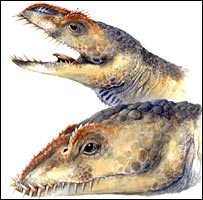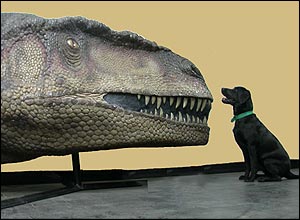In Australia, species of meat-eating dinosaurs were discovered that resembled the Loch Ness monster * In Argentina, a meat-eating dinosaur the size of T-REX was discovered that hunted in groups * Scientists discovered the skull of a rare creature from the age of dinosaurs
In Australia, species of meat-eating dinosaurs that resembled the Loch Ness monster were discovered
29.7.2006
By: Avi Blizovsky

Umoonasaurus. Above is an adult individual and below - a young one
Australia was once home to reptiles that swam in glacial lakes. This is evident from a number of recently discovered fossils. The giant meat-eating lizard lived 115 million years ago, during the time of the dinosaurs when most of the continent was covered by water.
Fossils of two new species of plesiosaur have been discovered near Coover Pedy in South Australia.
Plesiosaurs are popular creatures in science fiction books because they seem to have somewhat resembled the mythological monster Loch Ness. The Australian details are described in the latest issues of the journals Biology Letters and Palaeontology.
The length of one of these species, called Umoonasaurus demoscyllus, is 2.4 meters and it also had a large crest on its head, which was probably used to gain a reproductive advantage.
According to the lead researcher on both papers, Dr. Benjamin Kier of Adelheid University, the reptiles swam in the shallow waters of a sea that once existed in central Australia. A sea covered large parts of Australia 115 million years ago, when it was located closer to Antarctica.
The Omnosaurus was 2.4 meters long, and on its skull there were three grooves similar to a crown.
"Imagine a compact body with four fins, a long lizard neck, a small head and a short tail, almost like a crawling seal" said Kir. The other species, Opallionectes andamookaensis stood 5 meters long and had small needle-like teeth. About 30 fossils were discovered in a mine near the isolated mining town of Coober Pedy.
The genus Plesiosaurus is a type of extinct marine reptile with a long neck, small head, short tail and four limbs - probably fins. They first appeared at the beginning of the Jurassic period, and survived until 65 million years ago, when they became extinct along with all the dinosaurs and most species of life on Earth. The mineral opal filled the voids created when the bones decayed as the original rock that contained the fossils was washed away by the acidic groundwater. In the fossils are several skeletons as well as a complete skull of Umoonasaurus and a partial skeleton of Opallionectes.
It seems that these are young individuals, and this indicates that the lake was probably a spawning and breeding area for these reptiles. The scientists believe that the adults who lived in the sea returned to the shallow waters to breed and raise the young. At that time, Australia was a much colder place and the inland ocean was frozen in many areas during the winter.
The scientists believe that the creatures developed mechanisms that allowed them to survive in the harsh climate, such as a faster metabolic rate. They were meat eaters and fed on fish and squid.
In Argentina, a meat-eating dinosaur the size of a T-REX was discovered hunting in packs
19.4.2006
By: Avi Blizovsky
A PR photo of Maposaurus compared to a dog.

One of the largest meat-eating dinosaurs that hunted in packs was recently discovered in Argentina. In fact, the remains of seven mapusaurus (Mapusaurus roseae) were discovered together in an area rich in fossils in Patagonia.
A social hunting strategy may have allowed bipedal hunters to overcome even much larger herbivorous sauropods. Details of the discovery appear in the journal Geodiversitas.
One of the paper's authors, Rodolfo Correa of the Carmen Funas Museum in Plaza Huincol, Argentina, said their excavations revealed the social behavior of the Mapusaurimtz.
Hundreds of bones of several Mafuosaurus were found at the site but no bones of other creatures were found. According to Coria, the evidence shows that the animals were together before they died. It is also possible that they hunted in groups, but no direct evidence of this has been found. added
Philip Correa, from the University of Alberta in Canada estimated that hunting in groups could have allowed maposaurs to capture the largest known dinosaur - Argentinosaurus, a plant eater 37.5 meters long. "It is not clear whether these animals banded together to hunt, as wolves or lions do, or whether they simply gathered around prey or gathered after one of them killed the prey.
According to Kuria, it is difficult to know the length of the largest individual because no skeleton has been preserved intact. He estimates that the length of the maposaurs was about 12 meters.
Scientists have discovered the skull of a rare creature from the age of dinosaurs
Please meet: the Cadosaurus andinensis
18.11.2005
Courtesy of Walla news
The skull of the Cadosaurus andinensis, next to a computer simulation of a marine crocodile prepared by "National Geographic"
Argentina. The scientists call him "Godzilla", but in fact, he is more suitable for another movie - something between "Jaws" and "Jurassic Park". The creature in question, whose discovery was reported on Thursday in the online journal "ScienceExpress", is a large marine crocodile that lived 135 million years ago, in the midst of the age of the dinosaurs.
"It's like a crocodile with the head of a dinosaur," explained James Clark, a professor of biology at the University of Washington, who was not involved in the study. "This is something new and unusual. In the field of marine crocodile fossil research, this is a big story."
Unlike today's crocodiles, the discovered crocodile has a short snout, typical of a Tyrannosaurus rex dinosaur. Its jaws, which are almost half a meter long, include 52 large, sharp teeth, the kind that are capable of tearing pieces of flesh from the body of another creature. "I guess it wasn't a pretty sight," said Diego Paul, a researcher at the Institute for Mathematical Biology at Ohio State University, who was a member of the research team. "It is a predatory animal at the top of the food chain. This animal was one of the last of its family, and undoubtedly one of the strangest creatures of the crocodile family," he added.
Although it reached about four meters in length, it was not the longest crocodile of its time, nor was it the only one that lived in water. But what is special about it is the striking difference between it and other crocodiles, which usually have a long and narrow snout, and small, sharp teeth designed to catch fish. In addition, instead of four legs, it had four pedal-like fins, and a vertical tail, like a fish.
Zulma Gasparini, a paleontologist from the National University of La Plata in Argentina, was at the head of the study, which was funded with the help of the National Geographic Company, who uncovered a fossil of a complete skull of the crocodile of the unknown species, known as Cadosaurus andinensis. The fossil was discovered as early as 1996 in the Patagonia region, but the article published now summarizes nine years of research, during which the researchers also had to carefully remove the stone covering that wrapped the fossil.
The exposure of the complete skull skeleton teaches new details about the unknown species. According to Mark Norrell, curator of paleontology at the American Museum of Natural History, ecologically, this crocodile's role may have been the same as that of today's predatory whales. And according to Dr. Paul, it apparently fed on marine reptiles, such as ichthyosaurs, which looked like dolphins, or plesiosaurs, the slow marine reptiles with long necks.
Despite the shape of the skull, which is about 33 centimeters long, which is not typical for crocodiles, it includes some special characteristics, including the shape of the nostrils, the eye sockets and the upper part of the palate, which proved that it is a crocodile after all. In a meticulous examination of the skull by Dr. Paul and comparing it with other marine crocodiles of the same age, it was found that the unknown species is similar to the group of crocodiles with fish-like fins and tails. At the time when the decosaurs lived, the area where the fossils were found was located much further north, and was deep underwater, at the bottom of a deep tropical gulf that was connected to the Pacific Ocean.
